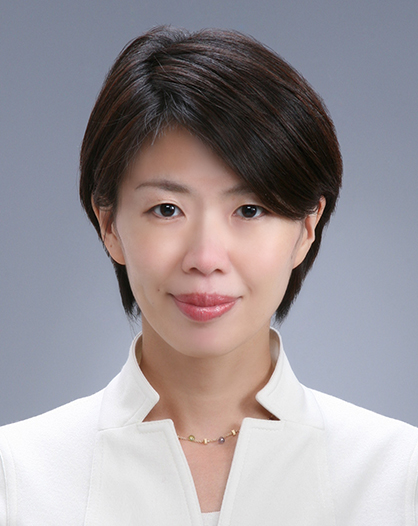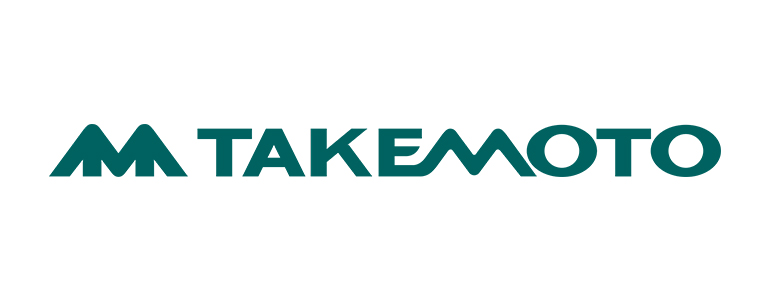| Takemoto Yohki Co., Ltd. (4248) |
|
||||||||||
Company |
Takemoto Yohki Co., Ltd. |
||
Stock Code |
4248 |
||
Exchange |
First Section, TSE |
||
Industry |
Chemical (Manufacturing) |
||
President |
Emiko Takemoto |
||
HQ Address |
2-21-5 Matsugaya, Taito-ku, Tokyo |
||
Year-end |
End December |
||
URL |
|||
* Stock price as of closing on March 27.
|
||||||||||||||||||||||||
|
|
* Estimates are those of the company. A 10 for 1 stock split was performed on September 12, 2014 and EPS and dividends have been retroactively adjusted to reflect this split.
We present this Bridge Report reviewing the fiscal year December 2017 business performance of Takemoto Yohki Co., Ltd.
|
| Key Points |
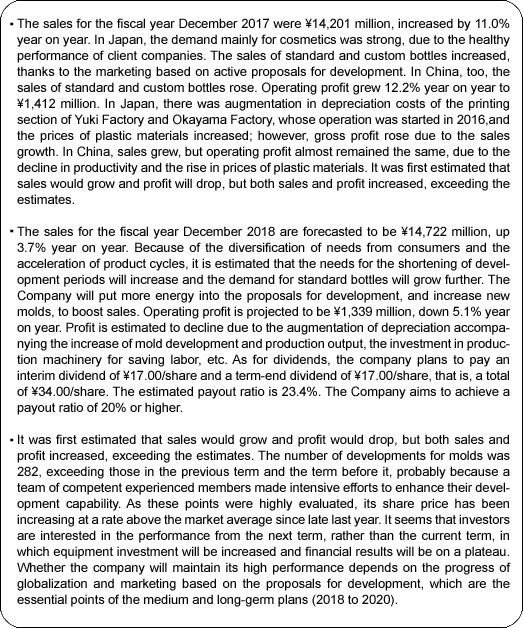 |
| Company Overview |
|
<Corporate History>
Shigeru Takemoto (Grandfather of the current President Emiko Takemoto) started his business under the name of Takemoto Shoten in 1950, amidst the shortages of goods in the post-World War II era, for the recycling of glass products. In 1953, Mr. Takemoto converted his business into a limited company and renamed it Takemoto Yohki Co., Ltd. and began selling glass containers. In 1963, Takemoto started dealing in its signature brand "standard bottles."A regional sales office was opened in Osaka in 1980. Masahide Takemoto (Currently advisor to the company and the father of Emiko Takemoto) took the helm of the company and explored new markets in the Kansai region, where its main sales had been limited to "custom made" products, with bottle dealers and accessory dealers being separated. In its efforts, the Company leveraged both the "standard bottles" and "one stop product provision." The wide range of products allowed the company to capture demand from customers and expand its sales channels. After the expansion into the Osaka region, a groundbreaking feat back then, the company further expanded into Fukuoka, Sapporo, and Nagoya regions, and succeeded in building its nationwide sales and service coverage network.
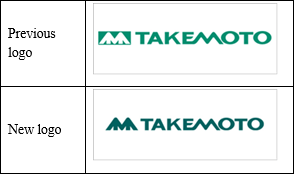  <Market Environment>
As demonstrated in the graph shown below, the market value of the shipments of packaging containers has trended sideways in recent years, and the outlook for declines in the Japanese population is expected to limit any increases in demand within Japan in the future.
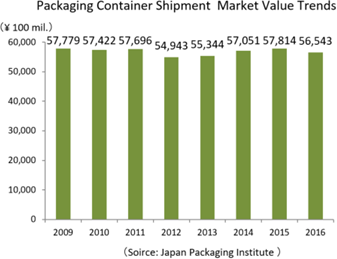 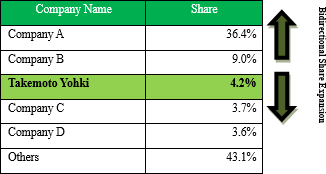 The main customers of Company A and Company B, the top two companies with the largest market shares, are large cosmetics companies which make mold investments on their own. Considering this fact, Takemoto Yohki, focused on its proposal-based marketing capabilities, which have been developed over a long time, as its distinctive strength, has established a mass production structure that delivers products speedily and precisely at a low price, also with partner manufacturers. With this structure, the company seeks to expand the sales of products made from molds manufactured by customers. Takemoto Yohki, a company which possesses both trading and manufacturing capabilities, has an advantage in terms of its product variety while most low market-share companies sell Standard Bottles through trading companies. By realizing cost reduction in development as a manufacturer, the company aims to improve the price competitiveness to increase its market share. In addition, because standard bottles which require mold investment need continual investment, strong financial capabilities are required. In this aspect, Takemoto Yohki, the only listed company in its industry, holds a major advantage. Like this, the company aims to expand its market share compared with upper and lower competitors. As mentioned later, the sales of products for cosmetics and beauty for the fiscal year December 2017 increased by 7.9% versus those in the previous term, with a higher growth rate than the average in the cosmetic market. The current market share is considered to be higher than the above mentioned 4.2% as of 2008. ◎ A growing overseas market
The cosmetics market in developing nations, primarily in Asia, is rapidly growing.In five years, the Chinese market has grown in scale by 50%. It is predicted to exceed that of Japan's by 2017 and India along with other ASEAN countries are expected to experience a high rate of growth as well. There is a high level of trust in Japanese-made bottles in developing countries which in itself has huge potential for business. <Business Description>
Takemoto Yohki Co., Ltd. manufactures and sells containers and accessories such as caps and dispensers, for use by customers in the cosmetics and beauty, general and health foods, sundries, and chemical and pharmaceuticals industries. The Company does not manufacture mere containers to hold substances; it primarily creates high value-added products while paying close attention to design, function, barriers, safety and environmental issues.
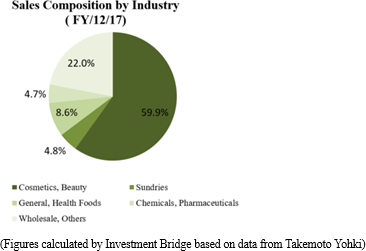 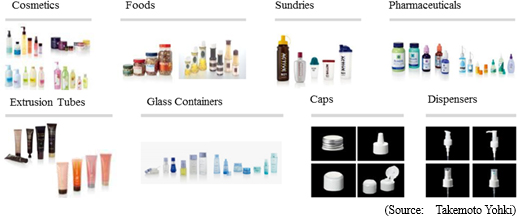 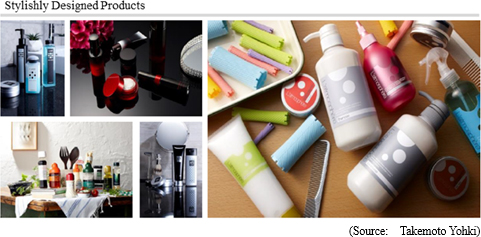 ◎ Business Model
When a cosmetics and toiletry product manufacturer customer commissions a container manufacturer to produce a unique and differentiated type of containers, in most cases the container manufacturer is responsible for design and manufacture of custom-made products while the customer shoulders the cost of creating molds. The time and cost of creating molds, however, is usually a heavy burden when sourcing containers because they take as long as three months and as much as several million yen.In contrast to the above, Takemoto Yohki creates molds in-house on behalf of the customer. Having allowed the customer to choose molds of its preference from a wide range of products, Takemoto manufactures and delivers the products. Therefore, the delivery time and development costs of packaging containers are reduced and customers can purchase only the required amount of containers as needed at the time. In this manner, Takemoto Yohki is able to plan and create its own brand of containers, which it calls "standard bottles," through this strategy of creating and owning the molds in-house. Takemoto owned 3,271 molds as of the end of December 2017 and boasts of the industry's largest collection of molds. At the same time, Takemoto can offer customized products that match customers' needs by using different caps and other accessory parts, and by changing the color and printing used on the Standard Bottle products. Furthermore, the company maintains inventories of certain products, helping it to realize short delivery times of a wide variety of products in small lots. 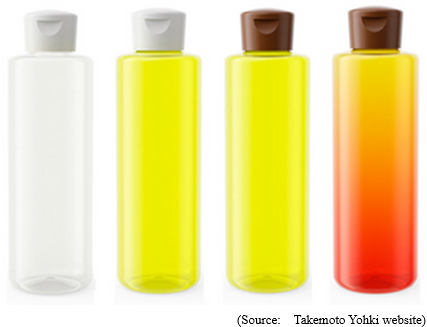 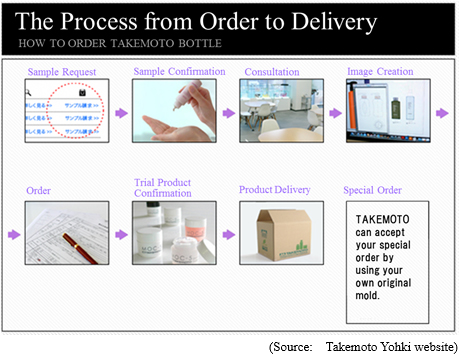 Standard Bottle sales comprise approximately 70% of total sales. In addition, the company deals in products made from molds manufactured by customers and, as part of its trading firm function, purchases products made by other companies. 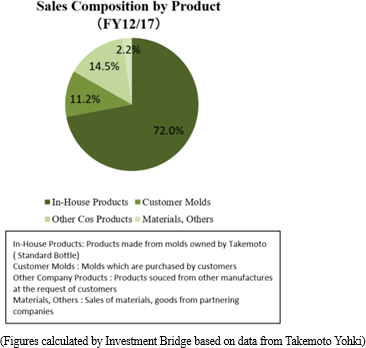 ◎ Production System
They have constructed a cooperative framework with outsourced manufacturers and possess 6 bases in Japan and 2 in China. Since Nov. 2016, Okayama Office has been operating to strengthen Western Japan's product supply system.Their domestic manufacturing thoroughly meets the needs of their clients, such as small batches and multi-products, short deadlines, stable quality, vast product line, sudden orders, and mass production. In China, they are concentrating on upgrading their production capabilities and improving their quality.  <Characteristics and Strengths>
Takemoto Yohki boasts of an extremely wide range of clients with some 4,500 customers within and outside Japan. In addition, no single client contributes more than 10% of the total sales and the stable cash flow secured from this client base enables continuous investment into molds. Furthermore, the company's high quality proposal-based marketing capability contributes to high levels of customer satisfaction and repeat business.
① Broad Customer Base ② Bountiful Stock of Molds
As explained earlier, the bountiful stock of 3,271 product molds allows Takemoto Yohki to respond flexibly to customers' needs. In addition, the company is fortifying its product lineup and promoting development of high-value- added container products with design and functionality taken into consideration. At the same time, efforts are being made to reduce investment burden and risks by standardizing, communizing, and miniaturization.
③ Flexible Product Supply Structure
Takemoto has built a structure that can supply a wide range of products in small volumes and in short delivery times through its manufacturing network of 6 plants within Japan and 2 in overseas markets. Moreover, new manufacturing technologies are being introduced aggressively with product cost, strength and quality in mind, and in order to respond to customers' needs for customized products.
④ "High Levels of Development and Proposal-Based Marketing"
The high levels of development and proposal-based marketing capabilities are the source of the sustained increase in corporate value and contribute to the establishment of a wide customer base. About thirty planning, development and technology staff endeavor to realize various ideas for products, taking material, shape, functionality, and safety into consideration. About 1,000 types of Standard Bottle brand products are on display at the Kappabashi Showroom and reflect the high levels of development and proposal-based marketing capabilities of the company.
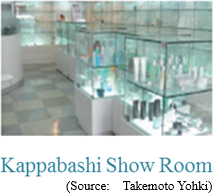 ⑤ Unique Business Model
Their 3 competitive factors of having a broad and vast client base (stable operating CF), abundant mold stock, and high capabilities in developmental proposals produce synergy and have built a business model unique to Takemoto Yohki.
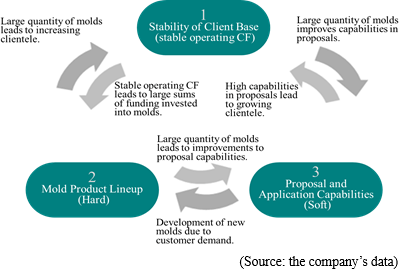 |
| Fiscal Year December 2017 Earnings Results Overview |
 Sales grew due to the good performance of standard and custom bottles, but profit declined due to the augmentation of depreciation, etc.
Sales were ¥14,201 million, up 11.0% year on year. In Japan, the demand mainly for cosmetics was strong, because the performance of client companies was healthy. The sales of standard and custom bottles increased, thanks to the marketing based on active proposals for development. Also in China, the sales of standard and custom bottles rose by ¥48 million year on year.Operating profit grew 12.2% year on year to ¥1,412 million. In Japan, there was augmentation in depreciation costs of the printing section of Yuki Factory and Okayama Factory, whose operation was started in 2016, and the prices of plastic materials increased, but gross profit rose due to the sales growth. In China, sales grew, but operating profit was unchanged, due to the decline in productivity and the rise in prices of plastic materials. For all categories of buyers, sales increased due to the enrichment of the lineup of standard bottles and the enhancement of marketing based on development proposals. The sales with other manufacturer's products are also growing continuously. It was first estimated that sales would grow and profit would drop, but both sales and profit increased, exceeding the estimates. 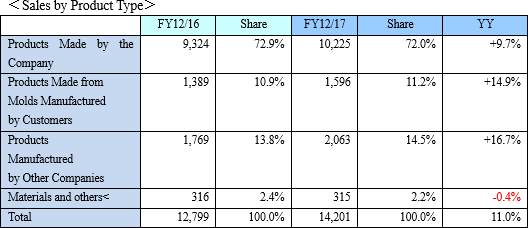  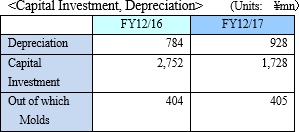  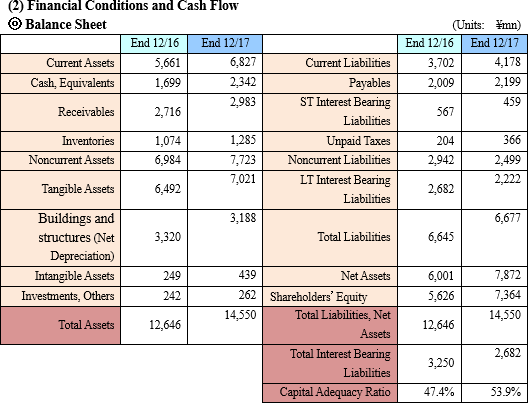 Net assets increased ¥1,871 million from the end of the previous term to ¥7,872 million, due to the growth of capital, capital surplus, and retained earnings. It has resulted in the capital adequacy ratio growth, 6.5% to 53.9%. 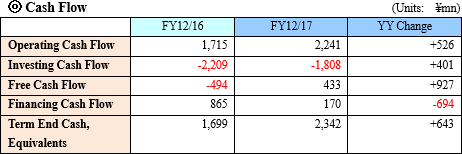 The deficit of investment CF shrank due to the decline in purchase of property, plant and equipment, and so free CF became positive. The surplus of financial CF decreased, as there was no longer income from long-term borrowing while there was income from the issuance of shares. The cash position rose ¥643 million from the end of the previous term to ¥2,342 million. (3) Topics
The number of molds of the company is 3,271 as of the end of December 2017.◎ Progress of mold development In Japan, the company outsources the production of molds to outside manufacturers, but the Chinese subsidiary produces molds by itself. Currently, the mold development sections in Japan and China are recruiting personnel and standardizing mold designs, while developing more functional molds. In addition, the company has worked on the development of molds for the factory in India, which is to be completed at the beginning of 2018.  ◎ The enlargement of Okayama Factory scheduled
The Company decided to enlarge the manufacturing facilities in Okayama Factory earlier than the initial plan, in order to support mass production. The construction was started in Feb. 2018, and is to be completed in Aug. 2018. |
| Fiscal Year December 2018 Earnings Estimates |
 Sales estimated to grow, but profit projected to decline due to the development of molds, increase in production output, and investment for labor saving
Sales are forecasted to be ¥14,722 million, up 3.7% year on year. Because of the diversification of needs from consumers and the acceleration of product cycles, it is estimated that the needs for the reduction of development cost and the shortening of development periods will increase and the demand for standard bottles will grow further. The Company will put more energy into the proposal for development, and increase new molds, to boost sales.Operating profit is projected to be ¥1,339 million, down 5.1% year on year. Profit is estimated to decline due to the augmentation of depreciation accompanying the increase of mold development and production output, the investment in production machinery for saving labor, etc. A full year dividend amount is ¥34.00/share, which is composed of an interim dividend of ¥17.00/share and a term-end dividend of ¥17.00/share. The estimated payout ratio is 23.4%. The Company aims to achieve a payout ratio of over 20%. 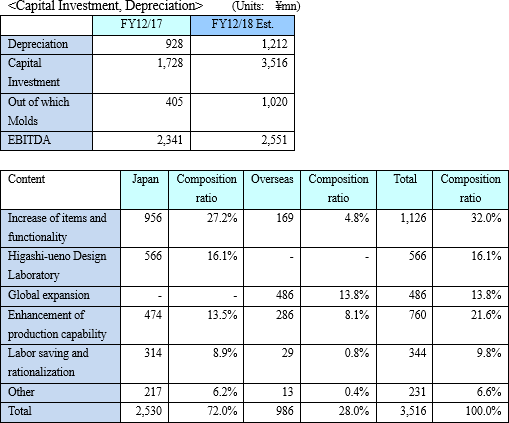  As of now, the international trade of products of the company is insignificant, and its influence on sales is limited. With respect to the yuan, the yen equivalent of sales of the Chinese subsidiary is considerable. With respect to the U.S. dollar, the scale of the U.S. subsidiary is small, but its influence on material procurement in Japan is relatively significant. |
| Medium/long-term plan (2018-2020) |
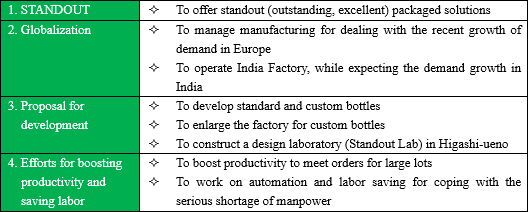 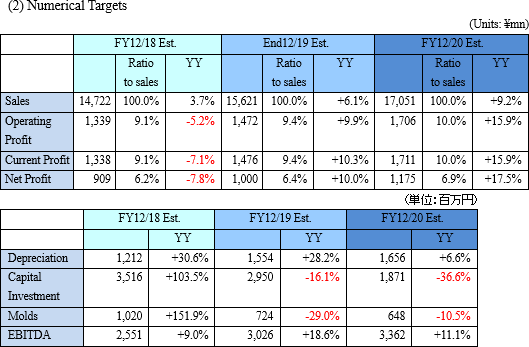 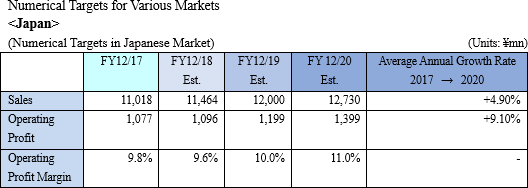 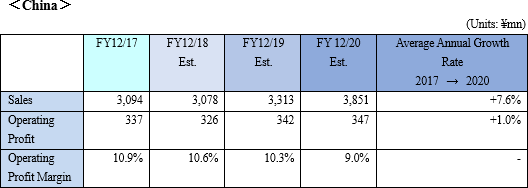  Setting the following goals about advantages, the company aims to brush up its capabilities further. 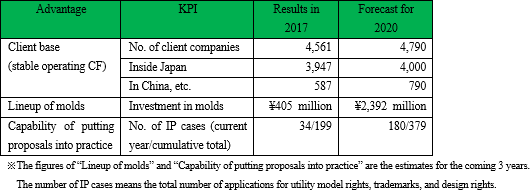 |
| Conclusions |
|
As these points were highly evaluated, its share price has been increasing at a rate above the market average since late last year. It seems that investors are interested in the performance from the next term, rather than the current term, in which equipment investment will be increased and financial results will be on a plateau. Whether the company will maintain its high performance depends on the progress of globalization and marketing based on the proposals for development, which are the essential points of the medium and long-germ plans (2018 to 2020). 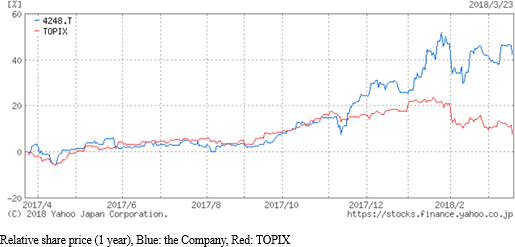 |
| <Reference: Regarding Corporate Governance> |
|
◎ Organizational Composition and Director and Auditor Composition
 ◎ Corporate Governance Report
Takemoto Yohki released its latest Corporate Governance Report on March 28, 2018.<Reasons for Non-compliance with the Principles of the Corporate Governance Code (Excerpts)> 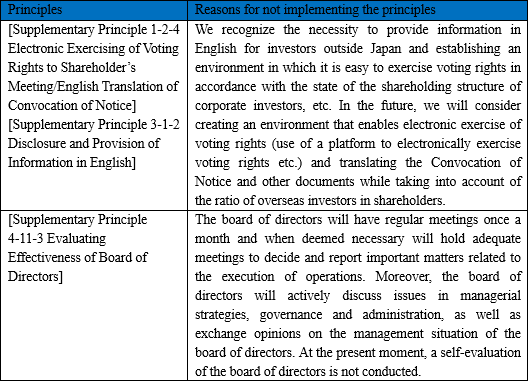 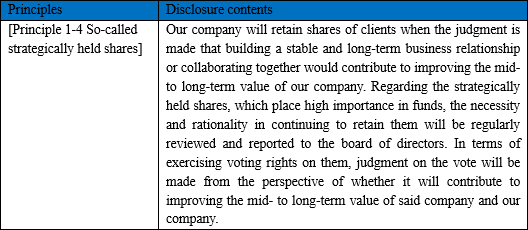 <Disclaimer>
This report is intended solely for information purposes, and is not intended as a solicitation to invest in the shares of this company. The information and opinions contained within this report are based on data made publicly available by the company, and comes from sources that we judge to be reliable. However we cannot guarantee the accuracy or completeness of the data. This report is not a guarantee of the accuracy, completeness or validity of said information and or opinions, nor do we bear any responsibility for the same. All rights pertaining to this report belong to Investment Bridge Co., Ltd., which may change the contents thereof at any time without prior notice. All investment decisions are the responsibility of the individual and should be made only after proper consideration.Copyright(C) 2018, Investment Bridge Co., Ltd. All Rights Reserved. |

